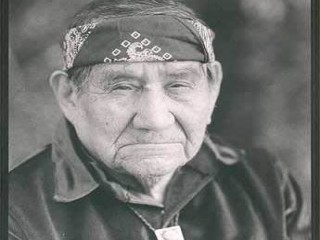
Harrison Begay biography
Date of birth : 1917-11-15
Date of death : -
Birthplace : White Cone, Arizona
Nationality : Navajo
Category : Arts and Entertainment
Last modified : 2011-06-06
Credited as : Artist painter, watercolors and silkscreen prints,
Harrison Begay is a Navajo artist who specializes in watercolors and silkscreen prints.
Harrison Begay is one of the most famous of all Navajo painters. His watercolors and silkscreen prints have been widely collected. His work, which has won 13 major awards, has a sinuous delicacy of line and is noted for its meticulous detail, restrained palette, and elegance of composition. His style has been so influential that disciples, like Baji Whitethorne, say that by studying his paintings one learns not only technique but also religion. The Navajo conception of the orderly balance of irreconcilable forces is exemplified in Begay's style, which is at once serenely still and vitally active.
Harrison Begay was born on November 15, 1917, at White Cone, Arizona, to Black Rock and Zonnie Tachinie Begay. His mother belonged to the Red Forehead Clan, and his father adopted the Zuni Deer Clan. He was said to have been related to Manuelita, an esteemed medicine man. The boy herded his family's flock of sheep near Greasewood, where he still lives. In 1927, he was sent to school at Fort Wingate, from which he ran away to spend the next four years at home, studying alone as he tended the sheep. In 1934, he attended Fort Defiance Indian School in New Mexico, and later Tohatchi Indian School. He graduated from high school in 1939 as salutatorian.
The institution that conferred distinction upon him was Dorothy Dunn's studio at the Santa Fe Indian School. Among Begay's classmates were other Navajo painters: Gerald Nailor, Quincy Tahoma, and Andy Tsinajinnie. They were taught to depict pastoral landscapes and tribal traditions in smoothly-brushed forms placed flat on the picture plane. In American Indian Painting, Dunn summed up Begay's work as "at once decorative and lifelike, his color clear in hue and even in value, his figures placid yet inwardly animated…. [H]e seemed to be inexhaustibly resourceful in a quiet reticent way."
In 1940, Begay married Ramona Espinosa; the couple divorced in 1945. Also in 1940, he attended Black Mountain College in Blueridge, North Carolina, to study architecture for one year. In 1941, he enrolled in Phoenix Junior College in Arizona.
Begay was one of the 21, 767 Native American veterans of the U.S. Army in World War II. From 1942 to 1945, Begay served in the signal corps. He participated in the Normandy campaign and was stationed in Iceland and in Europe. Upon his discharge, he stayed in Colorado until September of 1947. While there, he was briefly tutored by an artist in Denver. The army had trained him to be a radio technician, but his artistic talent enabled him to make a living as a full-time painter since his return to the reservation in 1947.
He was given space to paint at Clay Lockett's Arts and Crafts Shop in Tucson, Arizona. He also painted in Parkhurst's Shop in Santa Fe, New Mexico, and in Woodard's Shop in Gallup, New Mexico. He prefers to work in watercolors, usually casein paints because oil painting takes too long. A prolific artist, he regularly exhibits at the Philbrook Art Center each May, and at the Gallery in New Mexico that sponsors exhibits for five days in August each year at the Intertribal Indian Ceremonials. He won two grand awards at the Intertribal festivities and has been a consistent winner at state and tribal fairs. The French government honored him with its Palmes d'Academiques in 1945.
Begay cofounded TEWA Enterprises, which made silkscreen prints of his work. His fine-lined, flat-colored designs were eminently suitable for serigraph reproduction. This method of duplication also made his work affordable to the general public. Begay has also specialized in sensitive renditions of animals such as fawns, antelope, deer, sheep, and horses. He is also fond of depicting looms as subjects, as in his often reproduced painting, "Two Weavers" of 1946.
In 1959, Begay had an Enemyway chant performed for him. He paid the singer who conducted the rite to protect warriors against the ghosts of slain enemies with a set of three paintings of the Navajo sacred mountains. A similar set of the four sacred mountains, each associated with a different color and a different direction, is now owned by the Museum of Northern Arizona at Flagstaff. In order to compose these paintings, Begay studied the Navajo origin myths recorded by Washington Matthews.




















